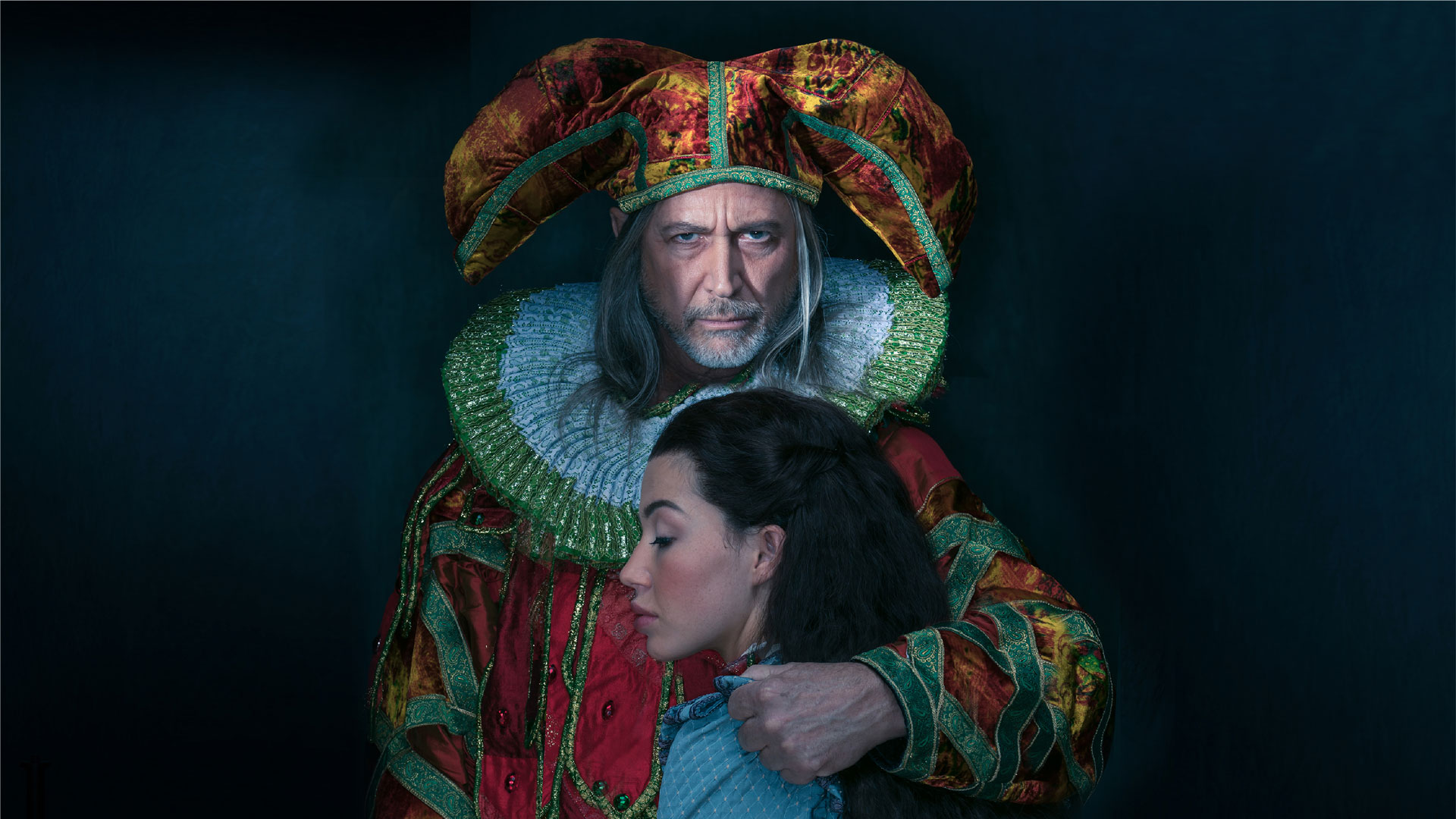Rigoletto 101 – Characters and Plot

By: Suzanne Whitney & Bethany Wood
The 2022-23 Season marks four decades of songs and stories at Opera Colorado. We are kicking off our 40th Anniversary Season with an Italian classic! Rigoletto is one of the archetypal operas for a reason. It features some of opera’s most-frequent tropes, like seduction, mistaken identities, and revenge gone wrong, alongside unforgettable music from Gilda’s sparkling and innocent “Caro nome” to the Duke of Mantua’s instantly recognizable “La donna è mobile.” Whether you come for the music or the drama, Verdi’s masterpiece has something for everyone.
In November of 2022, Opera Colorado will present a grand and classic production of Verdi’s Rigoletto. Before you head to the opera house, take some time to get to know the plot and our production!
The Creators of Rigoletto
Composer – Giuseppe Verdi (October 1813 – January 1901)
Librettist – Francesco Maria Piave (May 1810 – March 1876)
Source Material – Le roi s’amuse, a play written by Victor Hugo (February 1802 – May 1885)
The Characters of Rigoletto
Rigoletto (baritone) – The duke’s jester and father to Gilda. Played by Stephen Powell, making his Opera Colorado debut.
Gilda (soprano) – A young woman recently returned from a convent school and Rigoletto’s daughter. Played by Sharleen Joynt, making her Opera Colorado debut.
Duke of Mantua (tenor) – The hedonistic and unscrupulous ruler of Mantua. Played by Joshua Dennis, making his Opera Colorado debut.
Sparafucile (bass) – An assassin and brother to Maddalena. Played by Christian Zaremba, making his Opera Colorado debut.
Maddalena (mezzo-soprano) – A tavern worker, prostitute, and sister to Sparafucile. Played by Sandra Piques Eddy, who returns to Opera Colorado after playing Meg Page in Falstaff in 2018 and the title role in Carmen in 2014.
The Plot of Rigoletto
Rigoletto—Act I, scene 1
A grand room in the Duke of Mantua’s palace where the duke is giving a ball.
The Duke of Mantua enters with his courtier Borsa. The Duke tells Borsa of a lovely young woman he has seen, who only leaves her house to attend services at church. The Duke has determined to woo her, and plans to seek her out this very night.
While they are talking, the duke spies a beautiful woman at the ball, the Countess Ceprano, wife of the Count of Ceprano. Before the countess can leave with her husband, the duke commands her to stay and declares his love for her. Rigoletto, the duke’s jester, laughs at Ceprano’s predicament and urges the duke to murder the countess’ husband so the duke can have her for himself. Ceprano overhears Rigoletto plotting his murder and vows revenge, promising to teach Rigoletto a lesson he will never forget!
Meanwhile, the duke’s courtiers believe they have discovered Rigoletto’s secret—the jester has a mistress! The courtiers have all been targets of Rigoletto’s mockery at one time or another and agree to assist Ceprano with his revenge.
Suddenly, the Count of Monterone barges into the palace in a rage. Monterone cries out for justice for his daughter, whom the duke seduced and then abandoned. Rigoletto ridicules Monterone, mocks his grief. Enraged, Monterone rebukes the duke for preying on him in his old age, shames Rigoletto for deriding the tears of a father, and ends by cursing Rigoletto and the duke. Rigoletto is shaken, but the duke declares the curse is worthless and sentences Monterone to death.
Rigoletto—Act I, scene 2
The courtyard of Rigoletto’s house and a nearby street
As Rigoletto walks home later that night, he worries about Monterone’s curse. Near his home, Rigoletto meets a mysterious man with a sword—an assassin for hire named Sparafucile. The assassin offers his services, but Rigoletto refuses. As Sparafucile leaves, Rigoletto sings the famous aria “Pari siamo!” (“We are equals!”), declaring how he and the assassin are similar in character; Sparafucile stabs men with swords and Rigoletto stabs them with words. Rigoletto laments the vileness he spews for the amusement of the court.
As Rigoletto enters the courtyard of his house, his daughter Gilda runs to meet him. She has recently returned home after finishing her education at a convent, where Rigoletto sent her after her mother’s death. Gilda only knows Rigoletto as “father,” and asks him to reveal his name. Rigoletto refuses, telling her he is hated and has many enemies. Gilda is the only person in the world who loves him.
Gilda’s questions renew Rigoletto’s fear that the duke’s courtiers will kidnap her to exact revenge. He calls for Gilda’s guardian, Giovanna, who assures him she is always on guard. Just then, Rigoletto hears someone in the street. When he goes to check, the duke, disguised as a commoner, sneaks into the courtyard. He tosses Giovanna a bag of money to ensure her silence.
The duke has come to woo Gilda, the lovely woman he has seen at church. As he hides, the duke learns that Gilda is Rigoletto’s daughter! Rigoletto leaves, unaware the duke is in the courtyard with Gilda. The duke emerges from his hiding place and declares his love for Gilda but tells her he is a poor student named Gualtier Maldè. Unaware of his duplicitous character, Gilda pledges her love to the duke, promising to be his forever.
Suddenly, they hear someone coming. The duke flees, thinking it is Rigoletto, but the sound is really the duke’s courtiers, come to kidnap Gilda, whom they mistakenly believe is Rigoletto’s mistress. After the duke has fled, Gilda sings her famous aria “Caro nome” (“Sweet name”), praising the name of her beloved, ignorant that the name she worships is an alias the duke has used to deceive her.
Outside the courtyard, Rigoletto arrives just as the courtiers are about to climb over the wall. The courtiers trick Rigoletto into joining them, saying they are playing a joke on Ceprano. They give Rigoletto a mask to wear, but, in the dark, he does not realize it is really a blindfold. While Rigoletto steadies the ladder, the courtiers kidnap Gilda. Realizing something is wrong, Rigoletto tears off his mask and sees Gilda’s scarf on the ground. Monterone’s curse has come true—Rigoletto has lost his daughter to his enemies!
Rigoletto—Act II
A drawing room in the Duke of Mantua’s palace.
The duke worries about Gilda’s fate and vows to find who has taken her. Just then, the courtiers enter, laughing about how they have kidnapped Rigoletto’s mistress and brought her to the palace. The duke realizes they are the ones who have taken Gilda. Delighted she has been found and, even better, brought to his palace, the duke leaves to seduce Gilda.
Rigoletto enters and begs the courtiers to return his daughter, but they refuse. Gilda then enters, weeping because the duke has dishonored her. As father and daughter mourn, soldiers enter, escorting Monterone to his execution. Monterone expresses sorrow that he was unable to enact revenge on the duke. Gilda begs her father to forgive the duke, but Rigoletto vows to kill him.
Rigoletto—Act III
A dilapidated inn on the bank of the Mincio river on the outskirts of Mantua
Rigoletto tries to convince Gilda that he should kill the duke, but Gilda pleads with her father to forgive him. Determined to convince Gilda the duke is false, Rigoletto takes her to a dilapidated inn on the banks of the Mincio river, where Sparafucile, the assassin, lives with his sister Maddalena. The siblings use the inn to lure wayward travelers, whom they rob and murder.
Rigoletto and Gilda see the duke enter and flirt with Maddalena. Gilda’s heart is broken as she hears the duke promise Maddalena the same love and fidelity he once promised her.
Rigoletto sends Gilda home, telling her to disguise herself as a man and flee to Verona, where he will meet her later. He then pays Sparafucile to murder the duke, arranging to return at midnight to throw the duke’s body into the river personally.
After the duke falls asleep, Maddalena argues with her brother; she has fallen for the duke’s charms and does not want to kill him. Gilda, who has returned disguised as a man, overhears their conversation. She hears the siblings agree to kill any stranger who enters the inn and place the stranger’s body in a sack, which they will then give to Rigoletto, telling him it is the body of the duke. Maddalena agrees to the plan, but worries no one will come, since a violent storm is approaching. Summoning her courage, Gilda knocks on the door, determined to give her life in place of the duke’s. Maddalena opens the door, and lightning flashes as Gilda meets her death.
The storm diminishes, and Rigoletto enters to claim the duke’s corpse. Rigoletto gives Sparafucile the rest of his fee and carries the shrouded body to the river, rejoicing in his victory over the duke. Just as he is about to heave the corpse into the river, Rigoletto hears a voice singing. It is the duke!
Tearing the sack open, Rigoletto sees Gilda, who revives long enough to reveal what has happened. Crying out in despair, Rigoletto realizes Monterone’s curse has come to fruition—his actions have murdered his own daughter!
Synopsis by Bethany Wood, Ph.D.—Opera Colorado’s Manager of Education & Community Engagement.
If you made it through this whole post, you deserve to enjoy some of the music from this masterpiece! Experience Opera Colorado’s production of Rigoletto November 5-13! Tickets start at just $39>>
—
What is your favorite moment in Rigoletto? Is there anything you are dying to know about the opera or our production? Let us know in the comments below!



Ms. Whitney:
Thank you very much for posting “Rigoletto 101.” For the upcoming opera season, I purchased tickets for several newcomers for both Opera Colorado’s and The Dallas Opera’s performances of Rigoletto. Your synopsis will be very helpful to them. I would be very grateful if you could answer an question that’s puzzled me for decades. In Piave’s libretto, in what approximate year did the story of Rigoletto take place? Was it the 16th century? I read that Victor Hugo’s Le roi s’amuse was first staged in 1832, but I’d guess that the 19th century would be too late for the historical setting. I’d appreciate hearing your opinion.